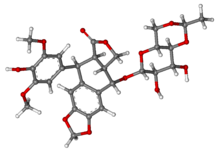Etoposide
 |
|
 |
|
| Clinical data | |
|---|---|
| Pronunciation | /ˌɛtoʊˈpoʊsaɪd/ |
| Trade names | Etopophos, Toposar, others |
| AHFS/Drugs.com | Monograph |
| MedlinePlus | a684055 |
| Pregnancy category |
|
| Routes of administration |
by mouth, intravenous |
| ATC code | L01CB01 (WHO) |
| Legal status | |
| Legal status | |
| Pharmacokinetic data | |
| Bioavailability | Highly variable, 25 to 75% |
| Protein binding | 97% |
| Metabolism | Liver (CYP3A4 involved) |
| Biological half-life | Oral: 6 h., IV: 6-12 h., IV in children: 3 h. |
| Excretion | Kidney and fecal |
| Identifiers | |
|
|
| Synonyms | VP-16; VP-16-213 |
| CAS Number |
33419-42-0 |
| PubChem (CID) | 36462 |
| IUPHAR/BPS | 6815 |
| DrugBank |
DB00773 |
| ChemSpider |
33510 |
| UNII |
6PLQ3CP4P3 |
| KEGG |
D00125 |
| ChEBI |
CHEBI:4911 |
| ChEMBL |
CHEMBL44657 |
| ECHA InfoCard | 100.046.812 |
| Chemical and physical data | |
| Formula | C29H32O13 |
| Molar mass | 588.557 g/mol |
| 3D model (Jmol) | Interactive image |
| Melting point | 243.5 °C (470.3 °F) |
|
|
|
|
Etoposide, sold under the brand name Etopophos among others, is a chemotherapy medication used for the treatments of a number of types of cancer. This includes testicular cancer, lung cancer, lymphoma, leukemia, neuroblastoma, and ovarian cancer. It is used by mouth or injection into a vein.
Side effects are very common. They can include low blood cell counts, vomiting, loss of appetite, diarrhea, hair loss, and fever. Other severe side effects include allergic reactions and low blood pressure. Use during pregnancy will likely harm the baby. Etoposide is in the topoisomerase inhibitor family of medication. It is believed to work by damaging DNA.
Etoposide was approved for medical use in the United States in 1983. It is on the World Health Organization's List of Essential Medicines, the most effective and safe medicines needed in a health system. The wholesale cost in the developing world is about 3.24 to 5.18 USD per 100 mg vial. In the United Kingdom this costs the NHS about 12.15 pounds as of 2015.
Etoposide is used as a form of chemotherapy for cancers such as Kaposi’s sarcoma, Ewing's sarcoma, lung cancer, testicular cancer, lymphoma, nonlymphocytic leukemia, and glioblastoma multiforme. It is often given in combination with other drugs (such as bleomycin in treating testicular cancer). It is also sometimes used in a conditioning regimen prior to a bone marrow or blood stem cell transplant.
...
Wikipedia
